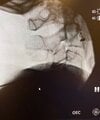View attachment 403214
Mystery diagnosis. 74F, afib w/ previous TIA, diabetic with A1c 6.4%. About 4 weeks ago she stumbled but caught herself and a couple hours later began experiencing severe pain down her left leg, predominantly in her posterior calf. I saw her 2 weeks ago and she had some mild dorsiflexion weakness. Saw her for a follow-up a week later and now she's 3/5 plantarflexion and 4/5 dorsiflexion. Got her admitted for a work-up. MRI brain non-revealing. MRI whole spine with mild degeneration, MRI lumbar spine report below. EMG/NCS will take a couple months due to lack of providers an the area. She's going to see Neurology at some point. Any thoughts on what it could be?
IMPRESSION:
1. Redemonstration of mild disc degeneration with mild spinal canal stenosis
at L2-L3 and L3-L4.
2. Multilevel neuroforaminal narrowing, most advanced to a moderate degree at
L4-L5 and on the left at L5-S1.



